Table of contents
- Automatic motorcycles in the test Aprilia NA 850 Mana versus Honda NC 700 S DCT
- Automatic motorcycles in the test
- Test result and rating
- Transmission variants in comparison
- Data and measured values
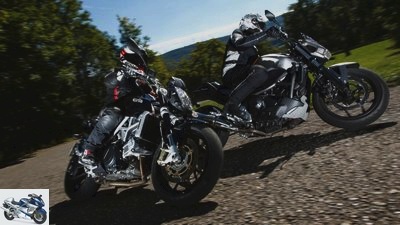
jkuenstle.de
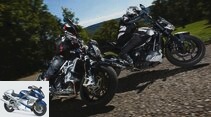
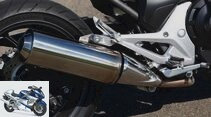
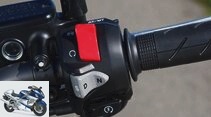
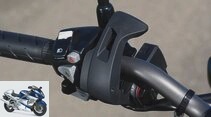
12th pictures
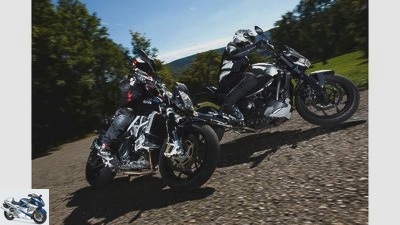
jkuenstle.de
1/12
Aprilia NA 850 Mana (variator) and Honda NC 700 S DCT (dual clutch transmission) – two automatic motorcycles in comparison.
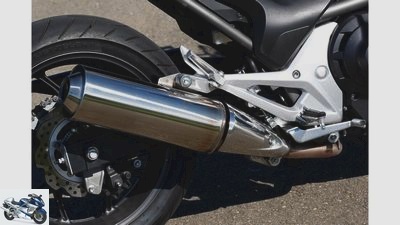
jkuenstle.de
2/12
Honda NC 700 S DCT: Two brake calipers are installed at the rear, the lower one being for the parking brake.
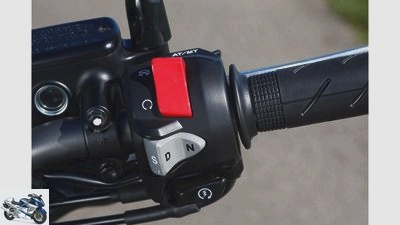
jkuenstle.de
3/12
Honda NC 700 S DCT: On the right the switch for the driving mode.
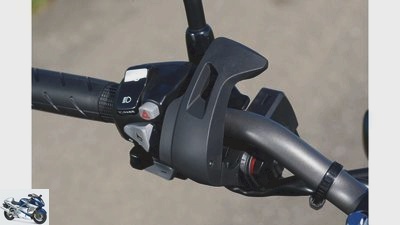
jkuenstle.de
4/12
Honda NC 700 S DCT: The parking brake is on the left of the handlebar.
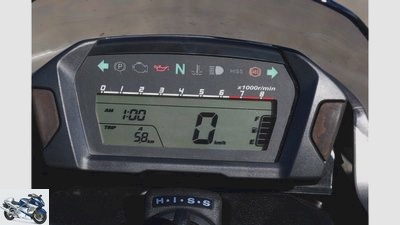
jkuenstle.de
5/12
Honda NC 700 S DCT: Fuel gauge, speed, time, total and trip odometer can be read off here.

jkuenstle.de
6/12
Honda NC 700 S DCT: Ten percent of all NC 700 S and X (220 units) sold in the country have so far been ordered with DCT.
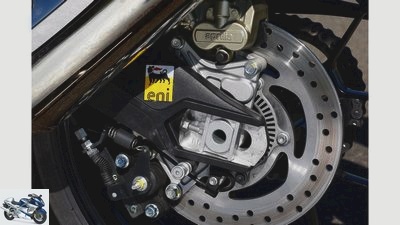
jkuenstle.de
7/12
The lower brake caliper is necessary as a parking brake for a safe stand.
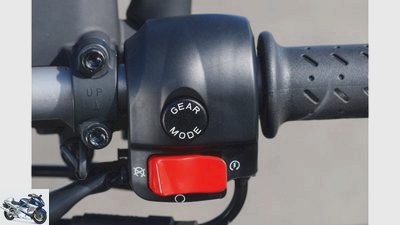
jkuenstle.de
8/12
There are three automatic modes and a manual mode to choose from for driving.
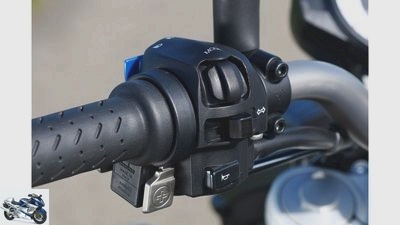
jkuenstle.de
9/12
Manual mode switch.
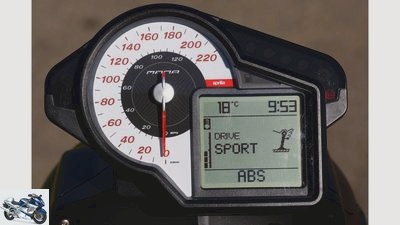
jkuenstle.de
10/12
Nicely designed cockpit that offers a lot of functionality except for a fuel gauge.
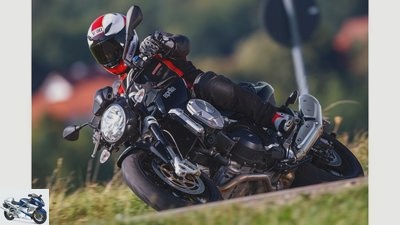
jkuenstle.de
11/12
Aprilia NA 850 Mana: The 850 Mana has certainly not been a sales success for Aprilia, although the concept is very well thought out.
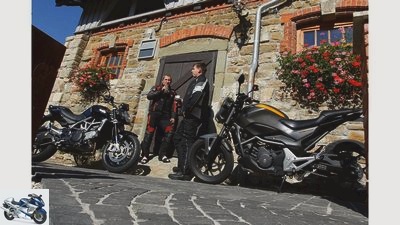
jkuenstle.de
12/12
In the end, the Honda NC 700 S DCT wins the comparison test in front of the Aprilia NA 850 Mana.
counselor
technology & future
Aprilia NA 850 Mana and Honda NC 700 S DCT in the test
Automatic motorcycles in the test
Aprilia NA 850 Mana versus Honda NC 700 S DCT
Why couple and shift gear yourself when technology can do it? Automatic motorcycles like Aprilia NA 850 Mana and Honda NC 700 S DCT are becoming more and more popular. But to whom are they useful, to whom perhaps rightly a thorn in the side? Variomatic and dual clutch transmission in comparison.
Roman Kirschbauer
09/27/2012
Automatic motorcycles in the test
An enormous proportion of the freshly produced vehicles in the automotive industry leave the factory with an automatic transmission. This equipment feature has not led to heated round table discussions for years, and hardly anyone complains about a restriction of freedom or critical gear changes. Rather, the opposite is true. Compared to the manual transmission, a modern automatic promises a gain in comfort and lightness and, in the best case, a plus in dynamics. Anyone who has ever driven a car with a dual clutch transmission will passionately confirm this.
Buy complete article
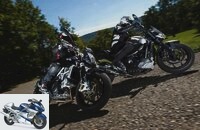
Automatic motorcycles in the test
Aprilia NA 850 Mana versus Honda NC 700 S DCT
6 pages) as PDF
€ 2.00
Buy now
Among motorcyclists, however, automatic motorcycles are viewed with ridicule, at best with skepticism, and there is even talk of a restriction of the entire “motorcycle philosophy”. But whether those skeptics have ever ridden such a bike and know how wonderfully it can work? Honda believes in at least a sustained trend and, following the VFR 1200 and Crosstourer, is also equipping the low-budget two-wheeler, NC 700 S and X, with an automatic dual clutch transmission (DCT) at an additional cost of 1000 euros. This combination of a cheap motorcycle with an elaborately manufactured double clutch, questionable at first glance, only becomes apparent when you look at the Honda Integra scooter.
It is based on the same engine and frame and, unlike the competition, has that double clutch with a classic gear transmission. Fortunately, the outside of the NC 700 S DCT does not show that it is related to a scooter. But this hybrid strategy between scooter and motorcycle is by no means new and innovative. The Aprilia Mana in the starting blocks. Its 90-degree V2 engine with 839 cubic centimeters comes from the Gilera GP 800 scooter and was technically adopted almost unchanged. The transmission ratio is continuously changed via a belt drive. Simply pull up the gas and glide smoothly over the country. For this, however, you have to accept the rubber band effect that is typical of scooters. But if you have a high-revving 50 cubic centimeter scooter in front of your eyes and in your ears, you’re really wrong.
The overall conception of the Mana is well thought out and harmonious down to the last detail. A push of the button, and the Aprilia-V2 with at least 76 HP crankshaft power bubbling freely. With this soundscape nobody thinks of a scooter. Visually, the Mana focuses entirely on Italian finesse and emotion, and when viewed more closely, it impresses with fine workmanship and amazing equipment features such as the eccentric adjustable tips of the brake pedal and the gearshift lever. Overall, the ergonomics are at a high level, even if the discreetly sporty knee angle does not really match the comparatively high handlebars. Is such a scooter fun? So bravely turn up the gas, let the centrifugal clutch do the frictional connection and try it out. The Aprilia sprints forward energetically. With a constant speed, the motor accelerates the mana powerfully and powerfully. No wonder, because the high basic speed level ensures full torque at all times of the propulsion, which is, however, also accompanied by strong vibrations. Relieved of any gear changes, you can fully concentrate on the ideal line. For a total weight of 229 kilograms, the Mana can be thrown comfortably and easily in an inclined position, then, supported by the perfectly functioning Pirelli tires, moves stoically and steadily on its way.
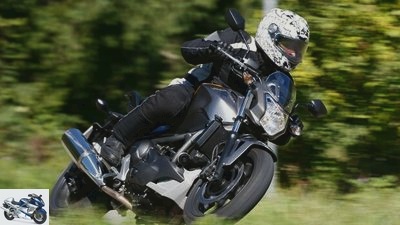
jkuenstle.de
Ten percent of all NC 700 S and X (220 units) sold in the country have so far been ordered with DCT.
After just half an hour of test drive through the Black Forest, tradition-conscious motorcyclists are amazed at how much you can do without real gear changes with inevitable load change reactions. The not ultra-direct, but quite brisk implementation of the gas commands in propulsion plays a significant role in this. Three automatic modes (Touring, Rain, Sport) are available and differ mainly in the basic speed level. If you want to determine the gear ratio yourself, you can do this using a hand switch or the well-known foot lever (surcharge Honda: 250 euros), as with the Honda. With the Mana, seven predefined translation levels can be called up sequentially. A servomotor changes the distance between the primary pulleys for this purpose. However, nobody needs this function, the variator harmonizes nicely with the V2 engine both when accelerating and when coasting. Even the engine braking torque can be used very well when the throttle valves are closed. So does the driving pleasure suffer from the rubber band effect? Definitely no. The driving pleasure is spoiled by inharmonious damping characteristics.
The upside-down fork is tuned too tight, and the shock absorber, which can be adjusted in terms of spring base and rebound, has a compression level that is far too low. On bad asphalt, the mana begins to stir properly in corners, hitting the line with continuity worthy of criticism. That’s pretty ugly. On the other hand, the ABS set-up is downright dangerous for journeys with a pillion passenger. If the radial Brembo brake calipers pack brutally into the large disks in solo operation and decelerate with the anti-lock braking system at fine control intervals, in two-man operation a rollover is almost inevitable without the driver intervening. The NC 700 S DCT can do this much better. But first things first.
A Honda dealer referred to the NC’s engine as a diesel engine a few days ago in view of its power delivery and hit the nail on the head. In general, this motorcycle is hard to beat in terms of simplicity. Get on, feel good, drive off. Everything is ergonomically in place, and there is nothing wrong with a long stage. As soon as the engine is started, the deep, forward-leaning in-line twin-cylinder immediately reveals its objective: pragmatism and economy. At the right end of the handlebar, you can choose one of the two driving modes: D for normal operation, S for more sporty locomotion. First gear is automatically engaged with a time delay. A careful twist on the throttle and, oops, the load makes an extremely motivated leap forward. The duel at the traffic lights is a real pleasure despite the maximum output of 48 hp. It’s pretty impressive how quickly the sprint succeeds from a standing start.
But the NC also has its qualities outside of the city. Like the Mana, for example, it has a usable storage compartment in the dummy tank for luggage (a full-face helmet fits into the NC, but the Mana doesn’t). In addition, it is also much better tuned on the chassis than the Aprilia. The shock absorber and conventional telescopic fork prove to be sporty, but not too tight. Uneven stretches are mastered much less agitated than with the Italian, and thanks to the low center of gravity and despite the ten kilograms more weight than the standard version of the NC 700 S, the Honda is still colossal. Even in deeper inclines, it remains consistently on the targeted line. And if you should have miscalculated before a curve, the single-disc brake at the front catches you properly and with the help of the safely tuned ABS. However, the hand strength required for this is very high compared to the mana. And how does the dual clutch transmission work now? Well, it reveals light and shadow at the same time. With a steady pull, the automatic shifts up very gently and quickly. Depending on the position of the throttle, the gear changes at a lower or higher speed.
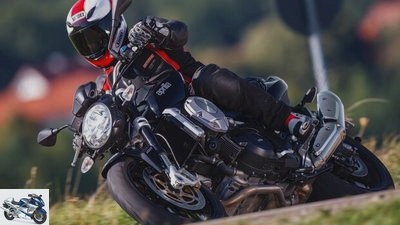
jkuenstle.de
The 850 Mana has certainly not been a sales success for Aprilia so far, although the concept is very well thought out.
Curvy stretches with tight bends require a little indulgence from all those who combine a pure relief function and an increase in comfort with an automatic. Because sometimes the automatic, especially in D mode, shifts up a gear shortly before the curve with the throttle grip remaining the same, and then shifts down again directly at the apex of the curve when the gas is applied. This necessitates unpleasant steering corrections. Many cornering is easier in S mode, as the gears are always turned out further. However, it can also happen here that when you accelerate gently in a full lean position, you unexpectedly shift into a higher gear, which at least causes irritation. The driver is called upon to adapt to such situations or to switch to manual operation. This downshift is particularly recommended at local entrances to utilize the engine braking torque, as sixth gear remains engaged up to just over 60 km / h. Ultimately, the constant, mostly superfluous switching back and forth between the individual gears is annoying when driving through town. The Aprilia is much more pleasant to drive here and the sum of its properties is particularly convincing to fans of well-kept comfort. In terms of points, however, the Honda wins thanks to its low maintenance costs and low fuel consumption.
Test result and rating
engine
The variator The Aprilia consistently delivers a lot of torque to the rear wheel. The top speed is also good at 200 km / h, as is the responsiveness and load change reactions. The Honda scores over the vibrating Aprilia with smoother running, but is punished in terms of acceleration, torque and top speed by its 48 hp.
Winner engine: Aprilia
Honda
The chassis design of the Honda is great. With firm, but not uncomfortable suspension elements, it can be driven through corners in a stable manner. The Aprilia suffers from its underdamped suspension strut, which transfers a considerable amount of unrest to the chassis when there are bumps in the road. With a pillion passenger, the situation worsens accordingly.
Chassis winner: Honda
everyday
In terms of ergonomics, the NC 700 S is designed to be more harmonious than the Aprilia. The Honda is outstanding above all because of its sensationally low fuel consumption, which is why it wins the chapter of range by a large margin despite the 14.1 liter fuel tank. The Aprilia, on the other hand, is well processed and impresses with its fine details.
Winner everyday: Honda
security
The braking effect of the mana is basically great. However, the set-up for rides with a passenger is too radical and a rollover is quite possible. The Honda brake works well, but requires a lot of hand strength.
Safety winner: Aprilia
costs
This is where the NC 700 S strikes. Inexpensive to maintain, 3.4 liters consumption per 100 kilometers. That fits.
Winner cost: Honda
Price-performance
Low consumption, a low price and 12,000 inspection intervals make the Honda a real bargain.
Price-performance winner: Honda
| maximum number of points | Aprilia | Honda | Overall rating | 1000 | 598 | 618 |
| placement | 2. | 1. | Price-performance note | 1.0 | 2.4 | 1.2 |
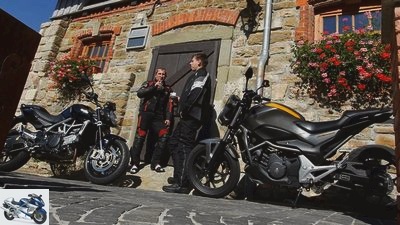
jkuenstle.de
In the end, the Honda NC 700 S DCT wins the comparison test in front of the Aprilia NA 850 Mana.
MOTORCYCLE test result
1. Honda NC 700 S DCT
The Honda impresses with its low-load, rapid gear changes, which, however, are not always useful or expedient in the automatic modes. It is more for technology lovers.
2nd April NA 850 Mana ABS
If you expect more comfort from an automatic, you can opt for the Aprilia. With proper pressure and finely tuned variator, it combines the advantages of a modern motorcycle with classic scooter technology in an almost exemplary manner.
Transmission variants in comparison
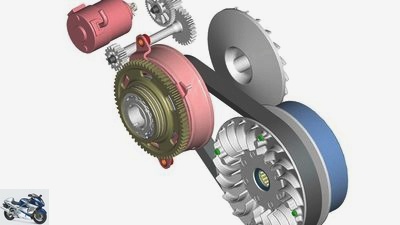
archive
With the variator, a V-belt runs between two conical primary belt pulley halves, the distance between which is variable.
When it comes to the technical implementation of an automatic transmission, Aprilia and Honda go fundamentally different ways. A closer look shows the respective construction effort.
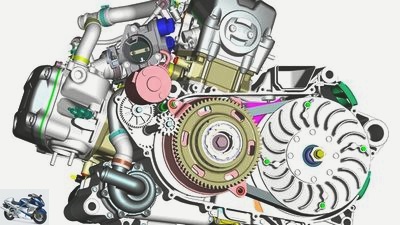
archive
A servomotor (colored pink) ensures the stepless adjustment of the transmission ratio.
The Mana gearbox is known from scooter construction, but is rarely used in motorcycles. The translation is changed via a V-belt, which runs on a primary pulley consisting of two conically shaped halves, the distance between which can be changed by means of a servomotor. When this happens, the belt moves to a higher or lower orbit and the diameter changes. However, since the V-belt has an unchangeable length, the orbit of the secondary wheel must be adapted in accordance with the variation in the distance between the primary belt pulleys. In simple terms, the orbit of the belt on the secondary wheel becomes smaller as the orbit on the primary pulley increases. The servomotor takes over this adjustment. In this way, a stepless change in the ratio is achieved. A classic centrifugal clutch creates the frictional connection to the crankshaft for starting. If the driver decides to manually select the gear ratio at Mana, the servomotor changes the distance between the primary pulley halves for a specific gear according to electronically stored parameters. So you can “upshift” or “downshift” accordingly.
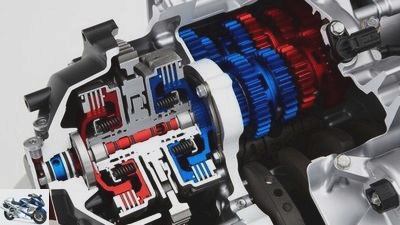
archive
The construction of a compact double clutch transmission is complicated and expensive.
The NC 700 S has two multi-disc oil bath clutches that operate independently of one another on the transmission input shaft. To take advantage of this design, the input shaft is divided into an inner and an outer shaft. The clutch for gears one, three and five is connected to the inner part (shown in red), and the clutch for gears two, four and six (shown in blue) is connected to the outer part. When starting off in first gear, clutch number one creates the frictional connection and the motorcycle starts moving. If the gear change is to take place in the next higher gear, the second clutch connects the corresponding gear pair for the second gear. Only when this process is completed does the first clutch release the frictional connection, the second immediately reestablishes the frictional connection with the crankshaft.
With this principle, gear changes are much faster than with a conventional gear transmission with a simple clutch. Supported by a lot of electronics and sensors, the entire coupling process runs fully automatically. It therefore makes sense to equip this system with automatic gear selection, as has also been done on all Honda models with DCT. The change in the throttle or throttle position is recognized by sensors and the (hopefully) desired gear ratio is calculated according to stored logarithms and forwarded to the clutch. This gear is structurally considerably more complex than the automatic belt system of the Mana.
Data and measured values
| Aprilia NA 850 Mana ABS | Honda NC 700s DCT | engine | design type | Cylinder four-stroke 90 degree V engine | Two-cylinder four-stroke in-line engine |
| injection | Ø 38 mm | Ø 36 mm | coupling | Centrifugal clutch | Double clutch |
| Bore x stroke | 88.0 x 69.0 mm | 73.0 x 80.0 mm | Displacement | 839 cm3 | 670 cm3 |
| compression | 10.0: 1 | 10.7: 1 | perfomance | 56.0 kW (76 PS) at 8000 rpm | 35.0 kW (48 hp) at 6250 rpm |
| Torque | 73 Nm at 5000 rpm | 60 Nm at 4750 rpm | landing gear | frame | Steel tubular space frame, supporting the engine | Bridge frame made of steel |
| fork | Upside-down fork, Ø 43 mm | Telescopic fork, Ø 41 mm | Brakes front / rear | Ø 320/240 mm | Ø 320/240 mm |
| Assistance systems | SECTION | Compound brake, ABS | bikes | 3.50 x 17; 6.00 x 17 | 3.5 x 17; 4.5 x 17 |
| tire |
120/70 ZR 17;
180/55 ZR 17
120/70 ZR 17
160/60 ZR 17
* Manufacturer information, ** MOTORCYCLE measurements, *** measured in automatic mode
Related articles
-
Bilski motorcycles Naked bike Top test Honda Hornet 600 Top test Honda Hornet 600 Salute Europe’s top seller 2002. Unfortunately only 25th in Germany. So…
-
Comparison test: Honda Hornet, Kawasaki Z 750, Suzuki GSR 600
Jahn motorcycles Comparison test: Honda Hornet, Kawasaki Z 750, Suzuki GSR 600 Comparison test: Honda Hornet, Kawasaki Z 750, Suzuki GSR 600 ABS shooters…
-
fact motorcycles Comparison test: Honda CBR 600 RR, Kawasaki ZX-6R, Suzuki GSX-R 600, Triumph Daytona 675, Yamaha YZF-R6 Comparison test: Honda CBR 600…
-
Honda NC 700 S in the test: the entry-level motorcycle from Honda
Artist 12th pictures Honda 1/12 Honda NC 700 S – The naked bike is powered by an in-line two-cylinder engine of 670 cubic meters. Honda 2/12 Honda NC 700…
-
Driving report Aprilia Mana GT 850 ABS
Aprilia motorcycles Driving report Aprilia Mana GT 850 ABS Driving report Aprilia Mana GT 850 ABS (2009) Half-boarded GT version of the V2 machine The…
-
Endurance test final balance Honda NC 700 S
Photo: www.r-photography.info 54 pictures www.jkuenstle.de 1/54 the Honda NC 700 S is a solid companion – not just for beginners. Gargolov 2/54 It was…
-
Jorg Kunstle motorcycles Top test Honda CBF 1000 Top test Honda CBF 1000 Fire day Amazing what can become of a super sports car. Honda combined the…
-
Bilski 15th pictures Bilski 1/15 The Honda CTX 700 N is the implementation of a very simple idea to combine the best attributes of cruiser and street…
-
markus-jahn.com 28 pictures markus-jahn.com 1/28 Honda Crossrunner. markus-jahn.com 2/28 The basic construction of the Crossrunner comes from the time…
-
Honda CB 500 in the 50,000 kilometer test
archive motorcycles Honda CB 500 in the 50,000 kilometer test Honda CB 500 in 50,000 kilometer test (1996) Classic bread-and-butter motorcycle So small,…